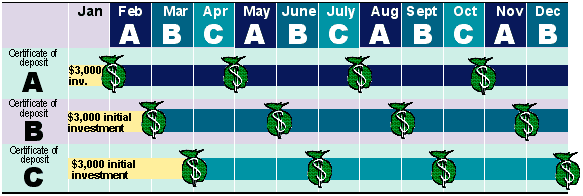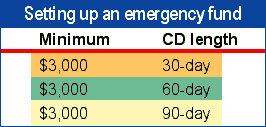
HOT TOPICS LIST
- Strategies
- Stocks
- Buy
- Investing
- Brokers
- Psychology
- Interviews
- Accumulate
- Sell
- Hold
- Spotlight
- Websites
- Candlestick Corner
- Gold & Metals
- Options Trading
LIST OF TOPICS
MONEY MANAGEMENT
The 411 On 911 Funds
11/22/00 03:19:59 PM PSTby David Penn
Protect your standard of living and pave the way for your investment plan. How? Set up an emergency fund using staggered certificates of deposit.
| Before embarking upon any investment plan, establish an emergency fund to protect yourself from a sudden drop in income. Without an emergency fund, even the best-laid investment plan can be forced off-track, as dollars that would otherwise be committed to building your retirement savings or college fund get diverted to take care of temporary crises. Because the most successful investment plans are those that take maximum advantage of the returns of the stock market, setting up an emergency fund as soon as possible will free your remaining money and allow you to fulfill your investment objectives. CDS TO THE RESCUE! Using staggered certificates of deposit (CDs) as the basis for an emergency fund provides a number of advantages over other sorts of cash or equity-based accounts. With staggered certificates of deposit, a set amount of money becomes available every month for use or reinvestment. If you have pressing needs, then that cash is readily available on a regular basis. If you don't, the certificate of deposit can simply be "rolled over," or reinvested, continuing to earn interest at a rate usually better than those of money market, checking, or savings accounts. An additional benefit of using CDs is that withdrawals are discouraged; while CDs can be redeemed at any time, there is a penalty for doing so. Often, this penalty amounts to little more than a few months' interest. But the penalty still serves as a significant disincentive (compared to a money market account, for example) against casual or frivolous withdrawals. After all, an emergency fund should only be tapped for, well, emergencies. Before introducing an example of an emergency fund built with staggered CDs, let's review.
The yield for the six-month CD is annualized, assuming reinvestment of principal and interest for a second six-month term. There is often a minimum investment for CDs, ranging from $500 to $100,000 for a 90-day jumbo CD?, with $1,000 being a common minimum for many banks and savings and loans. Unlike equities or most bonds, CDs are federally insured up to $100,000, which provides another measure of security that makes CDs a good way to build an emergency fund. CDs are also very easy to purchase. Shopping around for the best deal is equally simple; most daily newspapers publish yields on CDs offered by area banks in their financial section. Picking the best CD is simply a matter of comparing the advertised yields. THE PLAN IN MOTION To set up an emergency fund using staggered CDs, first you must determine your average monthly expenses, including rent or mortgage, utilities, and credit cards or other debt payments. An emergency fund should have enough money to support you in the event of income loss or other crisis for at least three months, although setting up a six-month fund is advisable where possible. For example, say your average monthly expenses are $3,000. In this case, you would need a minimum of $9,000 in order to set up a three-month emergency fund. A money market account is a good place to put the money you are saving toward your fund. Once you have raised your minimum amount, divide that amount by three (since you are setting up a three-month emergency fund). For the first $3,000, purchase a CD with a one-month term. For the second $3,000, purchase a two-month CD, and for the third $3,000, purchase a CD that matures in three months. (See Figure 1.)
Having done that, not only do you have an emergency fund to take some of the worry out of your life, but the emergency fund is gaining more interest than you might get through other cash instruments. And as your income or living expenses change, don't forget to adjust your CDs as they come due each month, adding whatever amount is necessary to keep up with your changing needs. There are, as you might imagine, variations on using staggered CDs as the foundation for an emergency fund; some investors, for example, might prefer a six-month emergency fund instead of a three-month fund. Such an emergency fund typically takes longer to deploy, but it's hard to beat the peace of mind that comes from having six months' worth of living expenses socked away in a federally insured account, earning interest of anywhere from 6.25% to 6.75%. The most important thing to remember about emergency funds is that they do more than prepare you for the inevitable bumps in the road, such as loss of income. Emergency funds help clear the way for you to dedicate as much as you can toward fulfilling your investment dreams. | |||||||||||
Technical Writer for Technical Analysis of STOCKS & COMMODITIES magazine, Working-Money.com, and Traders.com Advantage.
| Title: | Traders.com Technical Writer |
| Company: | Technical Analysis, Inc. |
| Address: | 4757 California Avenue SW |
| Seattle, WA 98116 | |
| Phone # for sales: | 206 938 0570 |
| Fax: | 206 938 1307 |
| Website: | www.traders.com |
| E-mail address: | DPenn@traders.com |
Traders' Resource Links | |
| Charting the Stock Market: The Wyckoff Method -- Books | |
| Working-Money.com -- Online Trading Services | |
| Traders.com Advantage -- Online Trading Services | |
| Technical Analysis of Stocks & Commodities -- Publications and Newsletters | |
| Working Money, at Working-Money.com -- Publications and Newsletters | |
| Traders.com Advantage -- Publications and Newsletters | |
| Professional Traders Starter Kit -- Software | |
PRINT THIS ARTICLE

|

Request Information From Our Sponsors
- StockCharts.com, Inc.
- Candle Patterns
- Candlestick Charting Explained
- Intermarket Technical Analysis
- John Murphy on Chart Analysis
- John Murphy's Chart Pattern Recognition
- John Murphy's Market Message
- MurphyExplainsMarketAnalysis-Intermarket Analysis
- MurphyExplainsMarketAnalysis-Visual Analysis
- StockCharts.com
- Technical Analysis of the Financial Markets
- The Visual Investor
- VectorVest, Inc.
- Executive Premier Workshop
- One-Day Options Course
- OptionsPro
- Retirement Income Workshop
- Sure-Fire Trading Systems (VectorVest, Inc.)
- Trading as a Business Workshop
- VectorVest 7 EOD
- VectorVest 7 RealTime/IntraDay
- VectorVest AutoTester
- VectorVest Educational Services
- VectorVest OnLine
- VectorVest Options Analyzer
- VectorVest ProGraphics v6.0
- VectorVest ProTrader 7
- VectorVest RealTime Derby Tool
- VectorVest Simulator
- VectorVest Variator
- VectorVest Watchdog


